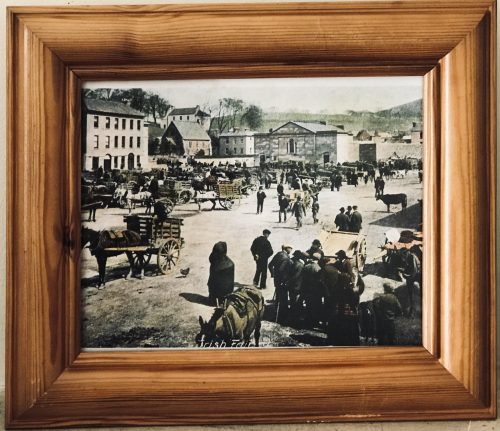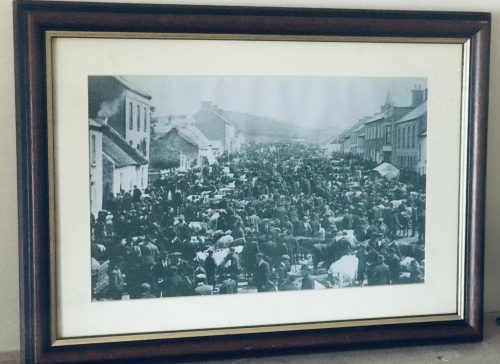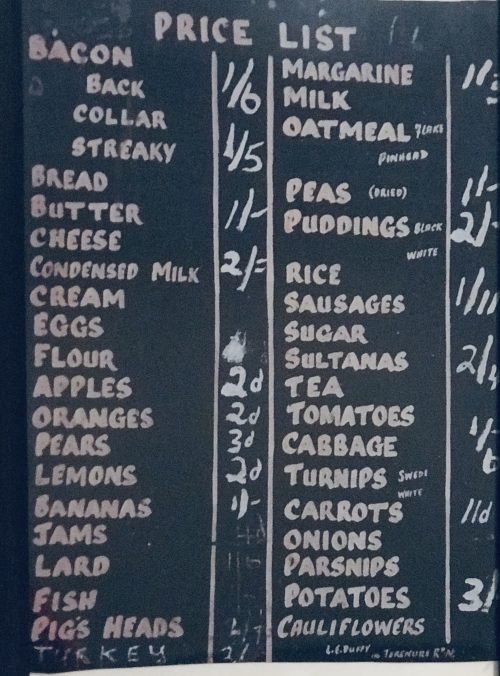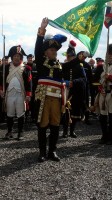-
 William Jameson Whisky Advert from the Cork Industrial Exhibition Programme in 1883. 30cm x 45cm Dublin William Jameson & Co (Marrowbone Lane Distillery) was an Irish whiskey distillery located on Marrowbone Lane, in Dublin, Ireland. One of the "big four" historical Dublin whiskey firms, it was run by William Jameson, a member of the Jameson whiskey dynasty. However, the whiskey now known as Jameson Irish Whiskey was not produced at this distillery, but at the separate enterprise run by John Jameson at the nearby Bow Street Distillery. The distillery closed in 1923 following financial difficulties.The precise origins of the distillery are uncertain, however, it was likely established in the 1750s (possibly 1752) and later acquired by the Stein family, relatives of the Jameson family circa 1780. An excise return in 1802 lists Stein and Jameson, however, by 1822 the company had become William Jameson & Co. Initially a small undertaking, with an output of just 30,000 gallons per annum, the distillery expanded over time, and by the time Alfred Barnard, a British historian visited the distillery in the 1880s, it had grown to cover some 14 acres.In his book, The Whisky Distilleries of the United Kingdom, Barnard described Marrowbone Lane as having some of the biggest distilling equipment in the world, including two mash tuns with capacities in excess of 100,000 gallons, which were the "said to be the largest in the United Kingdom". At its peak, the distillery was the second largest in Dublin (then one of the world's largest whiskey distilling centres), with an output of 900,000 gallons per annum, and a staff of 200, including 30 coopers. The whiskey produced at the distillery, known as "Dublin Whiskey" was chiefly exported to Australia, Canada, India and the United States. Later renamed the Dublin Distilling Company, the company entered financial difficulties in the late 1800s, and in 1891, merged with George Roe's Thomas Street Distillery and the Dublin Whiskey Distillery Company's Jones Road Distillery to form the Dublin Distilleries Company Ltd. Although, the amalgamated company had a potential production capacity of 3.5 million gallons per annum, it continued to endure severe financial difficulties, in particular, following the loss of both the American and British Commonwealth export markets during prohibition and the Anglo-Irish trade war in the 1920s. Both the Thomas Street and Marrowbone Lane distilleries closed in 1923, with the Jones Road Distillery following suit in 1926. Though distilling may have continued at Jones Road until 1946. During the 1916 Easter uprising, both the Marrowbone Lane distillery and Roe's distillery at Thomas Street were used as strongpoints by a force of more than a hundred rebels.
William Jameson Whisky Advert from the Cork Industrial Exhibition Programme in 1883. 30cm x 45cm Dublin William Jameson & Co (Marrowbone Lane Distillery) was an Irish whiskey distillery located on Marrowbone Lane, in Dublin, Ireland. One of the "big four" historical Dublin whiskey firms, it was run by William Jameson, a member of the Jameson whiskey dynasty. However, the whiskey now known as Jameson Irish Whiskey was not produced at this distillery, but at the separate enterprise run by John Jameson at the nearby Bow Street Distillery. The distillery closed in 1923 following financial difficulties.The precise origins of the distillery are uncertain, however, it was likely established in the 1750s (possibly 1752) and later acquired by the Stein family, relatives of the Jameson family circa 1780. An excise return in 1802 lists Stein and Jameson, however, by 1822 the company had become William Jameson & Co. Initially a small undertaking, with an output of just 30,000 gallons per annum, the distillery expanded over time, and by the time Alfred Barnard, a British historian visited the distillery in the 1880s, it had grown to cover some 14 acres.In his book, The Whisky Distilleries of the United Kingdom, Barnard described Marrowbone Lane as having some of the biggest distilling equipment in the world, including two mash tuns with capacities in excess of 100,000 gallons, which were the "said to be the largest in the United Kingdom". At its peak, the distillery was the second largest in Dublin (then one of the world's largest whiskey distilling centres), with an output of 900,000 gallons per annum, and a staff of 200, including 30 coopers. The whiskey produced at the distillery, known as "Dublin Whiskey" was chiefly exported to Australia, Canada, India and the United States. Later renamed the Dublin Distilling Company, the company entered financial difficulties in the late 1800s, and in 1891, merged with George Roe's Thomas Street Distillery and the Dublin Whiskey Distillery Company's Jones Road Distillery to form the Dublin Distilleries Company Ltd. Although, the amalgamated company had a potential production capacity of 3.5 million gallons per annum, it continued to endure severe financial difficulties, in particular, following the loss of both the American and British Commonwealth export markets during prohibition and the Anglo-Irish trade war in the 1920s. Both the Thomas Street and Marrowbone Lane distilleries closed in 1923, with the Jones Road Distillery following suit in 1926. Though distilling may have continued at Jones Road until 1946. During the 1916 Easter uprising, both the Marrowbone Lane distillery and Roe's distillery at Thomas Street were used as strongpoints by a force of more than a hundred rebels. -
 Tuttle's Horse Elixir -A boon for the Horse Owner ! Kilcullen Co Kildare. 62cm x 47cm Very rare and well framed Tuttle's Horse Elixir poster. The poster was published by Buck Printing Company located in Boston around 1885. The poster is marked "Tuttle's Horse Elixir - A Boon to the Horse Owner - Tuttle's Elixir Has won it's own merit as a leg and body wash. Accept no substitute as it has no equal... Sold By Druggists". It also shows an image of a man taking care of a horse. here was two companies running with similar names Tuttle's Elexer out of NY and Tuttle's Elixir Co. out of 19 Beverly St. Boston Mass. HISTORY OF TUTTLE’S ELEXER: Over a hundred years ago a veterinary surgeon named Dr.S.A. TUTTLE put together natural ingredients in the proper proportion to produce a unique liniment that is just as effective today as it was back in 1872. Dr. Tuttle began with denatured grain alcohol and gum turpentine. These are the solvents that carry the other active ingredients. Two essential oils, camphor and oil of hemlock, were added for their counterirritant and rubifacient effects. This stimulation of the skin and circulatory system generates natural warmth and delivery of the healing components of the blood.To enhance the effectiveness of these agents, Dr.Tuttle added ox gall, an ingredient with specific types of activity found exclusively in Tuttle’s ELEXER. Ox Gall is a unique ingredient that contains sodium salts of glycocholic and taurocholic acids and lecithin as key components.Glycocholic acid and taurocholic acids are powerful biological detergents that act to solubilize fats, and lecithin is a naturally occurring compound that acts as an emulsifier, stabilizer, antioxidant, lubricant and dispersant. This combination with the alcohol and other ingredients in Tuttle’s ELEXER makes it an excellent emulsifier of oil, grease and dirt for cleansing the affected area, particularly when mixed into a water solution. Tuttle’s ELEXER has been used by horse trainers in the U.S. since 1872. Manufactured from Dr. S.A. Tuttle’s original formula, there is no other preparation like it.
Tuttle's Horse Elixir -A boon for the Horse Owner ! Kilcullen Co Kildare. 62cm x 47cm Very rare and well framed Tuttle's Horse Elixir poster. The poster was published by Buck Printing Company located in Boston around 1885. The poster is marked "Tuttle's Horse Elixir - A Boon to the Horse Owner - Tuttle's Elixir Has won it's own merit as a leg and body wash. Accept no substitute as it has no equal... Sold By Druggists". It also shows an image of a man taking care of a horse. here was two companies running with similar names Tuttle's Elexer out of NY and Tuttle's Elixir Co. out of 19 Beverly St. Boston Mass. HISTORY OF TUTTLE’S ELEXER: Over a hundred years ago a veterinary surgeon named Dr.S.A. TUTTLE put together natural ingredients in the proper proportion to produce a unique liniment that is just as effective today as it was back in 1872. Dr. Tuttle began with denatured grain alcohol and gum turpentine. These are the solvents that carry the other active ingredients. Two essential oils, camphor and oil of hemlock, were added for their counterirritant and rubifacient effects. This stimulation of the skin and circulatory system generates natural warmth and delivery of the healing components of the blood.To enhance the effectiveness of these agents, Dr.Tuttle added ox gall, an ingredient with specific types of activity found exclusively in Tuttle’s ELEXER. Ox Gall is a unique ingredient that contains sodium salts of glycocholic and taurocholic acids and lecithin as key components.Glycocholic acid and taurocholic acids are powerful biological detergents that act to solubilize fats, and lecithin is a naturally occurring compound that acts as an emulsifier, stabilizer, antioxidant, lubricant and dispersant. This combination with the alcohol and other ingredients in Tuttle’s ELEXER makes it an excellent emulsifier of oil, grease and dirt for cleansing the affected area, particularly when mixed into a water solution. Tuttle’s ELEXER has been used by horse trainers in the U.S. since 1872. Manufactured from Dr. S.A. Tuttle’s original formula, there is no other preparation like it. -
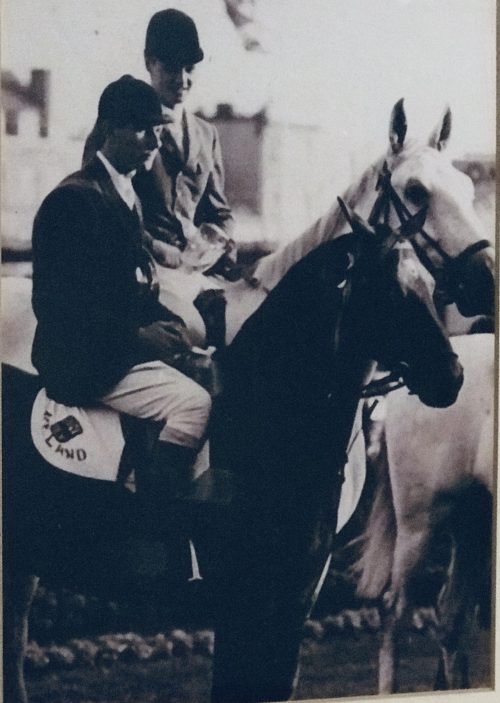
 30cm x 39cm Killenaule Co Tipperary
30cm x 39cm Killenaule Co TipperaryShowjumper helped transform the image of his sport in the 1960s but also attracted controversy
The showjumper Tommy Wade on his ''glorified'' Connemara pony, Dundrum, not only electrified audiences at the annual Horse Show in the RDS, Dublin in the 1960s but can be credited with popularising the sport of showjumping, then regarded as an elitist pursuit of the Anglo-Irish ascendency. Wade jumped a televised clear round in 1963 to clinch the Aga Khan trophy and the Nations Cup for Ireland in a thrilling conclusion to the annual Horse Show before an audience that included President Eamon De Valera. He had already created a sensation in 1961 by winning all five international classes at the show on Dundrum, described in some reports as "a former carthorse" that became a national celebrity and would inspire a later generation of horsemen like Eddie Macken and Paul Darragh. Shrouded in controversy, the outspoken Tipperary man arrived back in the RDS in 1967 vowing not to take part in any competitions, because of a dispute he was having with the Showjumping Association of Ireland over a show the previous week, where the judges had withheld the prize in a dispute with the riders. He relented when he was told that if he didn't take part in competition he would not be included in the Irish team. In the first round he incurred 22 penalty points and fell off his horse at the 11th fence. Due to the scores of his team-mates, Seamus Hayes, Billy Ringrose and Ned Campion, Ireland were still in contention at the end of the second round - but needed Wade and Dundrum to "go clear" to win. "Wade with icy calm and determination came into the ring," went one report of the event. "He and Dundrum approached each obstacle, willed on by an excited but tense and silent crowd. At a couple of fences the top pole trembled, but none fell. Finally, horse and rider sailed over the last jump for a clear round as wild cheering greeted the terse announcement of RDS secretary, John Whylie: 'Ireland have won the Aga Khan Cup.'" Wade said later: "He was like a little thoroughbred, he was all muscle, and he was a lovely horse to ride, strong and powerful." But within a couple of months Wade was suspended for a year from showjumping and was forced to take a job as a bookie at greyhound and race meetings around Munster. The suspension arose when he, his brother Ned and another rider Gerry Costelloe tied for first place at the Dungarvan Show in Co Waterford. They agreed to divide the €102 winner's purse, but the judges ordered them to jump again, which they felt would be hard on their horses going into the RDS the following week. Ned Wade came out, knocked the first fence and withdrew, Tommy went off before the starting bell and was eliminated and then Gerry Costelloe took the wrong course and was also eliminated. The judges were furious at what they believed was insubordination and refused to award the prize money. Wade demanded an apology and castigated what he insinuated were the Anglo-Irish ''bowler hat brigade'' who controlled the sport. "The showjumping crowd around Dublin are a rotten crowd, they're terrible jealous. The trouble with them is the trouble with Irish people generally: they're jealous of someone who gets to the top, Irish people still suffer from a peasant mentality," he said. Although he threatened to take his horses to northern England, near his friend Harvey Smith, peace was eventually made and Tommy Wade would later become Chef D'Equipe of the Irish showjumping team, claiming more than 30 Nations Cup victories at shows all over the world. Tommy Wade, who had earlier suffered a stroke, died last Monday aged 80 in the Bons Secours Hospital, Cork. Born at Gould's Cross at Camas, within sight of the Rock of Cashel, he went to school locally and later lived at Ballyroe House in Tipperary. His father was a local haulier and the family grew up in ''horse country'' steeped in racing and showjumping.Bred in the nearby village of Dundrum by Jack Ryan (Lar), the horse that made him famous had gone through several owners before Wade's father, Jimmy, spotted the gelding "hauling" goods for Tierney's hardware shop. Only five-and-a-half foot high, he began jumping at local shows before going to Manchester in 1957 where he won the North of England championship. "Tommy thought, dreamed and schemed about being first and usually was," said Michael Slavin in his book, Irish Showjumping Legends. It was an amateur sport at the time and he won a gold watch in Brussels, a gold tankard in Newcastle-upon-Tyne and a gold medal in Belfast - all trophies he treasured for the rest of his life. "I wasn't picked by the crowd here until I started getting invitations from England," he said, somewhat bitterly, later, when he was in dispute with the sports authorities. But they couldn't ignore him when Dundrum became Supreme Champion at the Wembley Horse of the Year Show and set a record clearing the seven foot two inches puissance wall. He was international Jumping Champion from 1959 to 1963. -

 Beautiful print of the original oil by the fascinating Irish artist Letitia Hamilton.This particular painting depicts the Meath Hunt. 30cm x 39cm Dunboyne Co Meath The last time the Olympic Games were held in London was in 1948, when they were known as the 'Austerity Games' because of the lean years after World War II. Ireland won one Olympic medal at those games, and amazingly it was not for a sporting feat, but for a discipline no longer regarded as an Olympic competition - art. The one Irish medal-winner was Dunboyne woman Letitia Hamilton, for her painting of a scene at the Meath Hunt Point-to-Point races. What was even more extraordinary was that the painting of horses was not regarded as Hamilton's forte - she was better known for her landscapes, many of which are today part of the Hugh Lane Gallery Collection in Dublin, with other appearing regularly at valuable art auctions. Recently, Ann Hamilton, widow of Letitia's nephew, Major Charles Hamilton of Dunboyne, attended a special celebratory dinner held at Farmleigh House for members of the 1948 Irish Olympic team, where she met many surviving members of their families. The 1948 Games was the last that featured the painting and art category. Letitia Hamilton's winning work was inspired by a country pursuit that was close to her heart. However, the whereabouts of that painting is unknown today. It is believed it may be in private ownership in the United States. Hamilton was one of a family of 10 of Charles Robert Hamilton and Louise Brooke and was known within the family as May. She was born in 1878 at Hamwood, which had been built a century earlier by another Charles Hamilton. Her family had an interesting artistic heritage. Her great-grandmother, Caroline Hamilton, was a professional artist and a distant cousin was the watercolour painter, Rose Barton. These examples may have encouraged her to regard art as a career and may also have inspired her sister, Eva, also an artist. Letitia was educated at Alexandra College, Dublin. Later, she studied at the Metropolitan School of Art where her teacher was Sir William Orpen, the famous Irish portrait painter. She then moved to London and studied with Anne St John Partridge. Afterwards, she went to study in Belgium under Frank Franywayn. In 1924, Letitia travelled to Italy to study with a master in Venice where she spent a year and painted some fine works. She returned to Ireland in 1925. In the years that followed, it was her custom to paint during the summer. During the winter, she worked on the paintings in her studio and in spring she exhibited her work. Her work was exhibited in a number of Dublin Galleries, such as The Dublin Painters' Gallery and the Royal Hibernian Academy. She also exhibited work in many London Galleries, including the Royal Academy and the French Gallery in Berkeley Square. During World War I, she nursed soldiers injured in the fighting. When her brother was appointed governor of St Patrick's Hospital in Dublin, and the associated Woodville in Lucan, now St Edmondsbury treatment centre, she lived at Woodville for a period. Ann Hamilton is in possession of a family scrapbook which includes the letter from AA Longden, art director of the XIVth Olympiad, informing Ms Hamilton that she had won third prize, a bronze medal with diploma, in Section II (a) of the Fine Arts Competition. He wrote: "I wish to congratulate you, on behalf of the committee, and to inform you that your medal and diploma have been handed to the chef to mission of your country for transmission to you. Please inform us when this has been received." The collection also includes a letter from JF Chisholm, the honorary secretary of the Irish Olympic Committee, and the card placed on the piece at the London show, announcing the win. Márin Allen, secretary of the arts section of the OCI , afterwards wrote that "in the painting section, where competition was stiffest and the standard high, Miss Letitia Hamilton, RHA, carried off the Bronze Medal, third place and diploma.....A few weeks ago, at a simple ceremony at the Royal Hibernian Academy in Dublin, Ireland's victors in the Fine Arts Competitions were presented with their awards by the National Olympic President, Col Eamonn Broy. In an atmosphere of homely friendliness, we talked and looked forward to Helsinki in 1952. On that occasion, Chef de Mission JF Chisholm made a suggestion which might, with advantage, be put into effect: the revival of the Tailteann Games in Ireland." The 1948 Olympic games in London were the first after a forced 12-year break because of World War II. The surviving members of the Irish team remember politics playing a major role in the Irish delegation as well. There were disagreements over whether the team should be a 26 or 32-county one. Part of the delegation was even sent home such was the level of disagreement. There was also an issue over the banner the Irish team was given to march under at the opening ceremony. The organisers gave the Irish team a banner with the word 'Eire' on it. The team manager refused to march under this banner, saying the country was called 'Ireland' and he wanted a banner to reflect this. With just minutes to go, the team capitulated and marched under the Eire banner because of the large number of Irish sports fans in Wembley stadium who had come to see them march in the opening parade. Also in London in 1948, in the literature section, Cavan-born Stanislaus Lynch's 'Echoes of the Hunting Horn' received a diploma. Mr Lynch lived at Tara in latter years and is buried in Skryne. Letitia Hamilton led a very active life until her passing in 1964, continuing to travel abroad. Her sister, Eva, died in 1960, and they are buried in the family burial plot at the Church of Ireland cemetery in Dunboyne.
Beautiful print of the original oil by the fascinating Irish artist Letitia Hamilton.This particular painting depicts the Meath Hunt. 30cm x 39cm Dunboyne Co Meath The last time the Olympic Games were held in London was in 1948, when they were known as the 'Austerity Games' because of the lean years after World War II. Ireland won one Olympic medal at those games, and amazingly it was not for a sporting feat, but for a discipline no longer regarded as an Olympic competition - art. The one Irish medal-winner was Dunboyne woman Letitia Hamilton, for her painting of a scene at the Meath Hunt Point-to-Point races. What was even more extraordinary was that the painting of horses was not regarded as Hamilton's forte - she was better known for her landscapes, many of which are today part of the Hugh Lane Gallery Collection in Dublin, with other appearing regularly at valuable art auctions. Recently, Ann Hamilton, widow of Letitia's nephew, Major Charles Hamilton of Dunboyne, attended a special celebratory dinner held at Farmleigh House for members of the 1948 Irish Olympic team, where she met many surviving members of their families. The 1948 Games was the last that featured the painting and art category. Letitia Hamilton's winning work was inspired by a country pursuit that was close to her heart. However, the whereabouts of that painting is unknown today. It is believed it may be in private ownership in the United States. Hamilton was one of a family of 10 of Charles Robert Hamilton and Louise Brooke and was known within the family as May. She was born in 1878 at Hamwood, which had been built a century earlier by another Charles Hamilton. Her family had an interesting artistic heritage. Her great-grandmother, Caroline Hamilton, was a professional artist and a distant cousin was the watercolour painter, Rose Barton. These examples may have encouraged her to regard art as a career and may also have inspired her sister, Eva, also an artist. Letitia was educated at Alexandra College, Dublin. Later, she studied at the Metropolitan School of Art where her teacher was Sir William Orpen, the famous Irish portrait painter. She then moved to London and studied with Anne St John Partridge. Afterwards, she went to study in Belgium under Frank Franywayn. In 1924, Letitia travelled to Italy to study with a master in Venice where she spent a year and painted some fine works. She returned to Ireland in 1925. In the years that followed, it was her custom to paint during the summer. During the winter, she worked on the paintings in her studio and in spring she exhibited her work. Her work was exhibited in a number of Dublin Galleries, such as The Dublin Painters' Gallery and the Royal Hibernian Academy. She also exhibited work in many London Galleries, including the Royal Academy and the French Gallery in Berkeley Square. During World War I, she nursed soldiers injured in the fighting. When her brother was appointed governor of St Patrick's Hospital in Dublin, and the associated Woodville in Lucan, now St Edmondsbury treatment centre, she lived at Woodville for a period. Ann Hamilton is in possession of a family scrapbook which includes the letter from AA Longden, art director of the XIVth Olympiad, informing Ms Hamilton that she had won third prize, a bronze medal with diploma, in Section II (a) of the Fine Arts Competition. He wrote: "I wish to congratulate you, on behalf of the committee, and to inform you that your medal and diploma have been handed to the chef to mission of your country for transmission to you. Please inform us when this has been received." The collection also includes a letter from JF Chisholm, the honorary secretary of the Irish Olympic Committee, and the card placed on the piece at the London show, announcing the win. Márin Allen, secretary of the arts section of the OCI , afterwards wrote that "in the painting section, where competition was stiffest and the standard high, Miss Letitia Hamilton, RHA, carried off the Bronze Medal, third place and diploma.....A few weeks ago, at a simple ceremony at the Royal Hibernian Academy in Dublin, Ireland's victors in the Fine Arts Competitions were presented with their awards by the National Olympic President, Col Eamonn Broy. In an atmosphere of homely friendliness, we talked and looked forward to Helsinki in 1952. On that occasion, Chef de Mission JF Chisholm made a suggestion which might, with advantage, be put into effect: the revival of the Tailteann Games in Ireland." The 1948 Olympic games in London were the first after a forced 12-year break because of World War II. The surviving members of the Irish team remember politics playing a major role in the Irish delegation as well. There were disagreements over whether the team should be a 26 or 32-county one. Part of the delegation was even sent home such was the level of disagreement. There was also an issue over the banner the Irish team was given to march under at the opening ceremony. The organisers gave the Irish team a banner with the word 'Eire' on it. The team manager refused to march under this banner, saying the country was called 'Ireland' and he wanted a banner to reflect this. With just minutes to go, the team capitulated and marched under the Eire banner because of the large number of Irish sports fans in Wembley stadium who had come to see them march in the opening parade. Also in London in 1948, in the literature section, Cavan-born Stanislaus Lynch's 'Echoes of the Hunting Horn' received a diploma. Mr Lynch lived at Tara in latter years and is buried in Skryne. Letitia Hamilton led a very active life until her passing in 1964, continuing to travel abroad. Her sister, Eva, died in 1960, and they are buried in the family burial plot at the Church of Ireland cemetery in Dunboyne. -

 Locke's Single Malt Old Irish Whiskey Advert Origins: Kilbeggan Co Westmeath Dimensions: 26cm x 26cm The Kilbeggan Distillery (formerly Brusna Distillery and Locke's Distillery) is an Irish whiskey distillery situated on the River Brosna in Kilbeggan, County Westmeath, Ireland. It is owned by Beam Suntory. A small pot still distillery, the licence to distil dates to 1757, a copy of which can be seen in the distillery. Similar to many Irish distilleries, Kilbeggan endured financial difficulties during the early 20th century, and ceased operations in 1957. However, the distillery was later refurbished, with distilling recommencing on-site in 2007. Noted devotees of the distillery's whiskeys include British Prime Minister Sir Winston Churchill, and Myles na gCopaleen, the Irish playwright.
Locke's Single Malt Old Irish Whiskey Advert Origins: Kilbeggan Co Westmeath Dimensions: 26cm x 26cm The Kilbeggan Distillery (formerly Brusna Distillery and Locke's Distillery) is an Irish whiskey distillery situated on the River Brosna in Kilbeggan, County Westmeath, Ireland. It is owned by Beam Suntory. A small pot still distillery, the licence to distil dates to 1757, a copy of which can be seen in the distillery. Similar to many Irish distilleries, Kilbeggan endured financial difficulties during the early 20th century, and ceased operations in 1957. However, the distillery was later refurbished, with distilling recommencing on-site in 2007. Noted devotees of the distillery's whiskeys include British Prime Minister Sir Winston Churchill, and Myles na gCopaleen, the Irish playwright.Early years
The distillery was founded in 1757 by Matthew MacManus, who may have distilled elsewhere before founding Kilbeggan.Although information about the early years of the distillery is scarce, documentation suggests that in its early years the distillery operated with a 232 gallon still, and an annual output of 1,500 gallons. By the early 19th century, the distillery was being run by a John and William Codd. In 1841, the distillery was put up for sale following the dissolution of the partnership between its then owners, William Codd and William Cuffee.The distillery at the time consisted of a brew house, still house with three pot stills (wash still: 8,000 gallons; low wine still, no. 1; 2,000 gallons; low wine still, no. 2: 1,500 gallons), run-room with five receivers, malt house, corn stores capable of storing 5,000 barrels, and oat-meal mills. Also listed in the sale were 400 tonnes of coal, and 10,000 boxes of turf - the latter reflecting the immense quantities of turf consumed at the distillery, so much so, that it was reported to have kept hundreds of poor people profitably employed in cutting, rearing, and drawing it to the town throughout the year.Locke's Distillery
In 1843, the distillery was taken over by John Locke, under whose stewardship the distillery flourished. Locke treated his staff well, and was held in high regard by both his workers and the people of the town. Informal records show that under Locke the distillery provided cottages for its employees, either for rent or purchase through a form of in-house mortgage scheme. In addition, all staff received a wagon load of coal at the start of each winter, the cost of which was deducted from salaries retrospectively on a weekly basis. Testimony of the respect with which he was held is offered by an incident in 1866. Following an accident on-site which had rendered a critical piece of equipment, the steam boiler, inoperable, the distillery had come to a standstill. With Locke unable to afford or obtain a loan to fund a replacement, the future of distillery lay in doubt.However, in a gesture of solidarity, the people of Kilbeggan came together and purchased a replacement boiler, which they presented to John Locke, along with the following public letter of appreciation, which was printed in several local newspapers at the time:An Address from the People of Kilbeggan to John Locke, Esq. Dear Sir - Permit us, your fellow townsmen, to assure of our deep and cordial sympathy in your loss and disappointment from the accident which occurred recently in your Distillery. Sincerely as we regret the accident, happily unattended with loss of life, we cannot but rejoice at the long-wished-for opportunity it affords us of testifying to you the high appreciation in which we hold you for your public and private worth. We are well aware that the restrictions imposed by recent legislation on that particular branch of Irish industry, with which you have been so long identified, have been attended with disastrous results to the trade, as is manifest in the long list of Distilleries now almost in ruins, and which were a few years ago centres of busy industry, affording remunerative employment to thousands of hands; and we are convinced the Kilbeggan Distillery would have long since swelled the dismal catalogue had it fallen into less energetic and enterprising hands. In such an event we would be compelled to witness the disheartening scene of a large number of our working population without employment during that period of the year when employment Is scarcest, and at the same time most essential to the poor. Independent then of what we owe you, on purely personal grounds, we feel we owe you a deep debt of gratitude for maintaining in our midst a manufacture which affords such extensive employment to our poor, and exercises so favourable an influence on the prosperity of the town. In conclusion, dear Sir, we beg your acceptance of a new steam boiler to replace the injured one, as testimony, inadequate though it is, of our unfeigned respect and esteems for you ; and we beg to present it with the ardent wish and earnest hope that, for many long years to come, it may contribute to enhance still more the deservedly high and increasing reputation of the Kilbeggan Distillery.
In a public response to mark the gift, also published in several newspapers, Locke thanked the people of Kilbeggan for their generosity, stating "...I feel this to be the proudest day of my life...". A plaque commemorating the event hangs in the distillery's restaurant today. In 1878, a fire broke out in the "can dip" (sampling) room of the distillery, and spread rapidly. Although, the fire was extinguished within an hour, it destroying a considerable portion of the front of the distillery and caused £400 worth of damage. Hundreds of gallons of new whiskey were also consumed in the blaze - however, the distillery is said to have been saved from further physical and financial ruin through the quick reaction of townsfolk who broke down the doors of the warehouses, and helped roll thousands of casks of ageing spirit down the street to safety. In 1887, the distillery was visited by Alfred Barnard, a British writer, as research for his book, "the Whiskey Distilleries of the United Kingdom". By then, the much enlarged distillery was being managed by John's sons, John Edward and James Harvey, who told Barnard that the distillery's output had more than doubled during the preceding ten years, and that they intended to install electric lighting.Barnard noted that the distillery, which he referred to as the "Brusna Distillery", named for the nearby river, was said to be the oldest in Ireland. According to Barnard, the distillery covered 5 acres, and employed a staff of about 70 men, with the aged and sick pensioned-off or assisted. At the time of his visit, the distillery was producing 157,200 proof gallons per annum, though it had the capacity to produce 200,000. The whiskey, which was sold primarily in Dublin, England, and "the Colonies", was "old pot still", produced using four pot stills (two wash stills: 10,320 / 8,436 gallons; and two spirit stills: 6,170 / 6,080 gallons), which had been installed by Millar and Company, Dublin. Barnard remarked that at the time of his visit over 2,000 casks of spirit were ageing in the distillery's bonded warehouses. In 1893, the distillery ceased to be privately held, and was converted a limited stock company, trading as John Locke & Co., Ltd., with nominal capital of £40,000.Decline and Closure
In the early part of the 20th century, Kilbeggan, like many Irish whiskey distilleries at the time, entered a period of decline. This was due to the combined effects of loss and hampering of market access - due to prohibition in the United States, the trade war with the British Empire, shipping difficulties during the world wars, and Irish Government export quotas; as well as competition from blended Scotch, and disruption to production during the Irish war of Independence. As a result, Kilbeggan was forced to cease production of new spirit for 7 years between 1924 and 1931, decimating the company's cash flow and finances.Most of the staff at the distillery were let go, and the distillery slowly sold off its stocks of aged whiskey. Distilling resumed in 1931, following the end of prohibition in the United States, and for a time the distillery's finances improved - with a loss of £83 in 1931, converted to a modest profit of £6,700 in 1939. In the 1920s, both of John sons passed away, John in 1920, and James in 1927, and ownership of the distillery passed to Locke's granddaughters, Mary Evelyn and Florence Emily.However, by then the distillery was in need to repair, with the turbulent economic conditions of the early 20th century having meant that no investment had been made in new plant since the 1890s. In 1947, the Lockes decided to put the distillery was put up for sale as a going concern. Although run down, the distillery had valuable stocks of mature whiskey, a valuable commodity in post-war Europe.An offer of £305,000 was received from a Swiss investor fronted by an Englishman, going by the name of Horace Smith.Their unstated interest, was not the business itself, but the 60,000 gallons of whiskey stocks, which they hoped to sell on the black market in England at £11 a gallon - thus, more than doubling their investment overnight. However, when they failed to come up with the deposit, the duo were arrested and promptly interrogated by Irish police. The Englishman, it turned out, was an impostor named Maximoe, who was wanted by Scotland Yard.]The Irish authorities placed Maximoe on a ferry back to England for extradition, but he jumped overboard and escaped with the help of unknown accomplices. An Irish opposition politician, Oliver J. Flanagan, subsequently alleged under parliamentary privilege that members of the governing Fianna Fáil political party were linked to the deal, accusing then Irish Taoiseach Éamon de Valera and his son of having accepted gold watches from the Swiss businessman. A tribunal of inquiry discounted the allegations but the damage contributed to Fianna Fáil's defeat in the 1948 election. In addition, as the scandal remained headline news in Ireland for several months, it discouraged interest from other investors in the distillery. Thus with no buyer found, operations continued at the distillery, with production averaging between 120,000 - 150,000 proof gallons per annum, and consumption running at between 15,000 - 20,000 barrels of barrel.In addition, although heavily indebted, investments were made in new plant and equipment. However, the death knell for the distillery came in April 1952, when the Irish Government introduced a 28% hike in the excise duties on spirits, causing a drastic decline in domestic whiskey sales. By November 1953, the distillery could not afford to pay the duty to release whiskey ordered for Christmas from bond, and production was forced to come to a halt. Although distilling had stopped, the firm struggled on until 27 November 1958, when a debenture issued in 1953 fell due, which the distillery could not afford to pay, forcing the bank to call in the receivers. Thus, bringing to an end 201 years of distilling in the town. In 1962, the distillery was purchased for £10,000 by Karl Heinz Moller, a German businessman, who owned a motor distribution company in Hamburg.Moller made a substantial profit on the deal, by selling off the whiskey stocks (about 100,000 gallons - worth tens of thousands of pounds alone) and a rare Mercedes Benz owned by the distillery. Much to the dismay of locals, Moller proceeded to convert the distillery into a pigsty, smashing thousands of Locke earthenware crocks (which would be worth a substantial amount at auction today) to create a hard-core base for the concrete floor. In 1969, the distillery was sold to Powerscreen, a firm which sold Volvo loading shovels, and in the early 1970s, the stills and worms were removed and sold for scrap.Distillery reopens
In 1982, almost thirty years after the distillery ceased operations, the Kilbeggan Preservation and Development Association was formed by locals in the town. Using funds raised locally, the Association restored the Distillery, and reopened it to the public as a whiskey distillery museum. Then, in 1987, the newly opened Cooley Distillery acquired the assets of Kilbeggan distillery, allowing Cooley to relaunch whiskeys under the Kilbeggan and Locke's Whiskey brands. Cooley later also took over the running of the museum, and began the process of re-establishing a working distillery on-site. Cooley were aided in the process by the fact that since the distillery's closure, each subsequent owner had faithfully paid the £5 annual fee to maintain the distilling licence. In 2007, the 250th anniversary of the distillery's founding, distillation recommenced at Kilbeggan. The official firing of the pot stills was witnessed by direct descendants of the three families, the McManuses, the Codds, and the Lockes, who had run the distillery during its 200 year distilling history. In a fitting nod to the long history of distilling at Kilbeggan, one of the two pot stills installed in the refurbished distillery was a 180-year old pot still, which had originally been installed at the Old Tullamore Distillery in the early 1800s.] It is the oldest working pot still producing whiskey in the world today. In 2010, with the installation of a mash tun and fermentation vats, Kilbeggan became a fully operational distillery once again.Present day
Today the distillery is known as Kilbeggan Distillery, and includes a restaurant, The Pantry Restaurant, and a 19th-century waterwheel that has been restored to working condition. The distillery can also be powered by a steam engine, which is in working condition but rarely used. It was installed to allow the distillery to continue operating in times of low water on the river. Prior to the recommencement of operations of Kilbeggan, the three brands associated with the distillery—Kilbeggan, Locke's Blend and Locke's Malt were produced at the Cooley Distillery in County Louth, before being transported to Kilbeggan, where they were to stored in a 200 year old granite warehouse. However, following recommencement of operations at Kilbeggan, new whiskey produced on-site has been sufficiently mature for market since around 2014. Since reopening, the distillery has launched a Kilbeggan Small Batch Rye, the first whiskey to be 100% distilled and matured on-site since the restoration was completed. Double-distilled, the whiskey is produced from a mash of malt, barley, and about 30% rye, said to reflect the traditional practice of using rye, which was common at 19th century Irish distilleries, but has since virtually died out. In late 2009, the distillery released small '3-pack' samples of its still-developing "new make spirit" at 1 month, 1 year, and 2 years of age (in Ireland, the spirit must be aged a minimum of three years before it can legally be called "whiskey"). The distillery's visitor centre was among the nominations in Whisky Magazine's Icons of Whisky visitor attraction category in 2008.Gallery
-
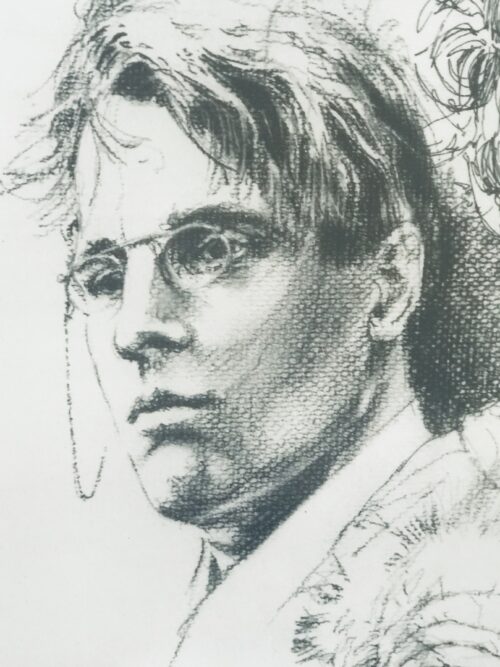
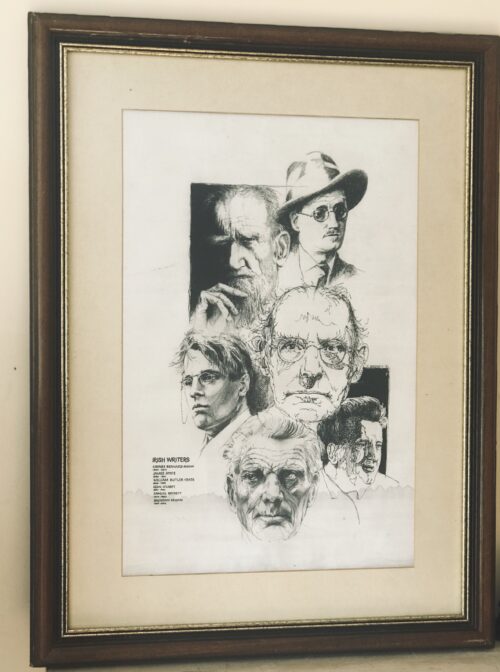 Striking and large print of a drawing on charcoal depicting five Irish Literary behemoths-James Joyce,W.B Yeats ,Samuel Beckett,Brendan Behan & Sean O'Casey.There is some slight water staining on the bottom of the front as this was stored in the basement of a long closed Dublin pub but now gladly resurrected and reframed. Dublin 90cm x 68cm
Striking and large print of a drawing on charcoal depicting five Irish Literary behemoths-James Joyce,W.B Yeats ,Samuel Beckett,Brendan Behan & Sean O'Casey.There is some slight water staining on the bottom of the front as this was stored in the basement of a long closed Dublin pub but now gladly resurrected and reframed. Dublin 90cm x 68cm -
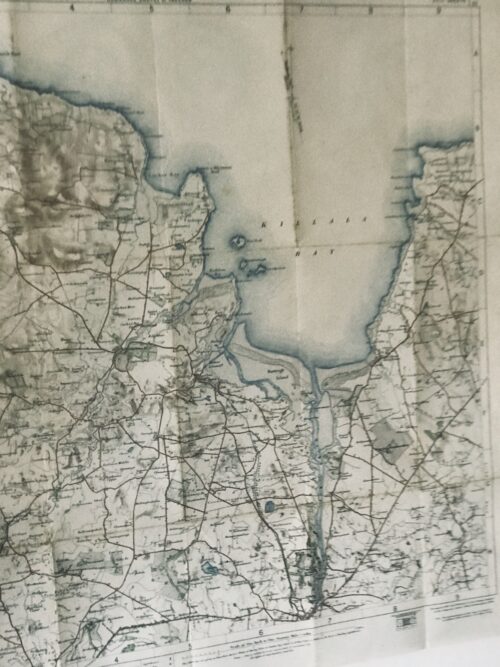
 Original ordnance survey map from 19 of Killala Bay Co Mayo in superb frame. Westport Co Mayo 65cm x 65cm Killala is a quiet seaside resort but the harbour warehouses show that it was once a busy port. This remote little town enjoys a place of disproportionate importance in the history of Ireland, as it was here that the French first halted when they invaded in 1798. The 1798 French invasion of Ireland On August 6, 1798, General Humbert’s “Army of Ireland” set sail from La Rochelle destined for Killala, Co. Mayo …
Original ordnance survey map from 19 of Killala Bay Co Mayo in superb frame. Westport Co Mayo 65cm x 65cm Killala is a quiet seaside resort but the harbour warehouses show that it was once a busy port. This remote little town enjoys a place of disproportionate importance in the history of Ireland, as it was here that the French first halted when they invaded in 1798. The 1798 French invasion of Ireland On August 6, 1798, General Humbert’s “Army of Ireland” set sail from La Rochelle destined for Killala, Co. Mayo …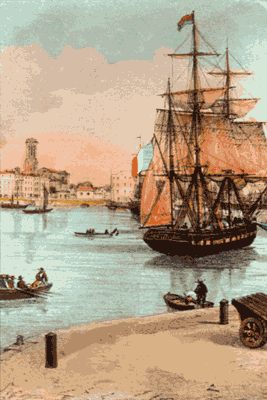
La Rochelle’s harbour.
On July 19, 1798, the French Directory authorises the sending of three expeditions to Ireland and gives command of the first one to General Humbert.
On August 6, 1798, General Humbert’s Army of Ireland sailed from La Rochelle in three frigates La Concorde, La Franchise, La Médée, carrying 1,025 French troops, 3 light field cannons, 3,000 muskets, and 400 sabres.
There were also a number of Irish among Humbert’s command. These included Bartholomew Teeling and Fr. Henry O Kane. This tiny force, together with its Irish allies, was to conduct an extraordinary campaign that shook the British Empire.During 16 days they sailed taking a circuitous route to avoid detection by the British navy. The mission of this little French expeditionary force was to provide military assistance to the Irish rebels of the “Rising of ’98” – sometimes referred to as “Bliadhan na bhFrancach” or “The Year of the French” – in their attempt to free Ireland from English domination.
The fleet had originally planned to land in Co. Donegal, but due to storm and no doubt influenced by the presence of Fr. O Kane who was a native of Killala the fleet sailed into Killala Bay.
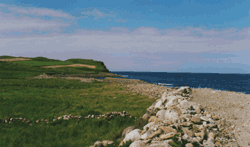
Kilcumminn head, Co. Mayo
On the 22nd of August, 1798, the three frigates landed at Kilcummin flying the English colours.
Edwin and Arthur Stock, sons of the Protestant Bishop of Killala, who had sailed out to meet them, greeted them. The two were captured, the English flag taken down and the French flag hoisted.
One of the first to disembark was Fr. O Kane who spoke to the locals in Irish which was the native tongue of most of the Irish at that time. Word soon filtered to native Irish throughout Mayo and Sligo.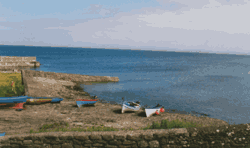
Kilcumminn strand,landing-place of the French
Bishop Stock also heard of the arrival and he sent messages to the local gentry among them the Jacksons, the Knoxs, Binghams, Palmers and Kirkwoods. Into the relative quiescence of northwest Ireland, the French expeditionary force fell like a thunderbolt. By about 7pm the landing was complete.
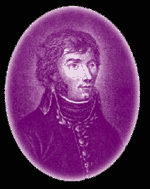
General Humbert
Young Général Jean-Joseph-Amable Humbert (the landing occurred on his 31st birthday), a canny veteran of irregular warfare against the insurgents of the Vendée, was well aware of the odds against him in a conventional military showdown, but also of the multiplying effects of surprise and speed.
He was also keenly aware of the importance of early victory for exciting the morale of the Irish insurgents and dismaying the ill-trained loyalist militia.
The first military confrontation occurred on the afternoon of 22 August, when Colonel Jean Sarrazin led a group of French Grenadiers south to the nearby village of Killala.

Killala, viewed from the north.
The garrison of 200 men included a handful of regulars of the 17th Foot (Leicestershire Regiment), but was mostly composed of the Yeomanry, an ill-trained part-time paramilitary constabulary.
With a portion of Sarrazin’s force circling around the British left flank and the remainder pressing a frontal attack with the bayonet, the unnerved Loyalists fired one ragged volley and then fled in terror towards Ballina.
Three Frenchmen were slightly wounded, bishop Stock’s palace was taken over as Humbert’s H.Q. and several of the yeomen were taken prisoner.

Ireland forever – l’Irlande pour toujours
A French soldier then climbed to the top of the palace and removed the British flag, which was replaced by a green and gold flag bearing the inscription ‘Erin Go Bragh’ (Ireland forever).
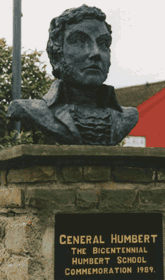
General Humbert statue in Killala.
LIBERTY, EQUALITY, FRATERNITY, UNION “After several unsuccessful attempts behold at last Frenchmen arrived amongst you . . . “Brave Irishmen, our cause is common. Like you we hold as indefeasible the right of all nations to liberty. Like you we are persuaded that the peace of the world shall ever be troubled as long as the British ministry is suffered to make with impunity a traffic of the industry and blood of the people . . . “Union, Liberty, the Irish Republic! Such is our shout. Let us march. Our hearts are devoted to you; our glory is in your happiness.”
From General Humbert’s Proclamation of 22nd August, 1798. (This last sentence of Humbert’s Proclamation became our pub’s motto!)
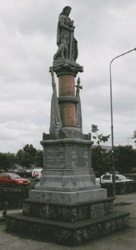
Mémorial de Ballina
This initial humbling of their oppressors had the desired effect on the local population, bringing forward thousands of eager, though ignorant and ill-disciplined Irish volunteers who were hastily equipped and formed into companies. Muskets were issued to some, but as in the uprisings elsewhere in Ireland that year, most of the insurgents were armed with crude pikes, scythes, and hay-forks.
On the 24th of August, having captured Killala, Humbert sent two groups under Sarrazin (provisionally promoted to Général de Brigade by Humbert on 23 August) and Adjudant-General Fontaine to capture Ballina.That night a fight took place between Sarrazin’s troops and the British at Rosserk. The English eventually retreated in confusion. The next morning the French/Irish troops captured Ballina under cover of darkness. The Irish peasants lit bundles of straw to show them their way. This approach road to Ballina has since been known as Bothair na Sop. They took Ballina without much resistance. The English for the most part fled towards Foxford where they would have their forces waiting for the French advance on Castlebar.
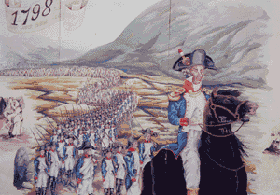
Humbert – Windy Gap Pass
The British commander in County Mayo, General Hutchinson, expected Humbert to continue south along the only decent road out of Ballina toward Castlebar, the commercial and strategic center of the region.
Where the road crosses the River Moy at Foxford, Hutchinson placed a strong blocking force with ample artillery. Clashes of French and British patrols along the Ballina-Foxford road appeared to confirm British expectations.Humbert, closely questioning the locals, learned that there was an alternative route to Castlebar, a barely-practicable goat-trail that ran west of Lough Conn, over the Windy Gap pass, and then south to the town. He resolved to take this route.
To further the deception, the Franco-Irish forces marched out of Ballina along the Foxford road at sunset on August 26 with ostentatious noise and shouted boasts of expected victory at Foxford, then doubled back in silence and darkness to the west of Loch Conn. At midnight, Humbert’s army was in Lahardane.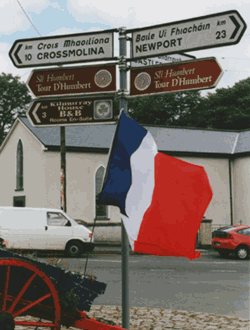
“Tour D’Humbert” signposts in Lahardane
The local priest, Father Andrew Conroy, was fluent in French from his time at seminary in Nantes.
He gave precious directions to the French officers and marshalled the people to provide food and assistance to the troops. In the aftermath of the campaign, Father Conroy was arrested, tried, and executed by the vengeful British.After a rigorous night-march of 40 km (25 miles), Humbert’s 800 French, 600 Irish, and 1 laboriously manhandled gun reached Castlebar on 27 August.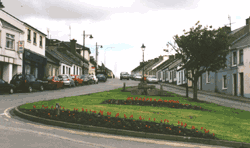
Sion Hill (now built-up)
A yeoman farmer who had been tending to his cattle had spotted the French/Irish advance party. He immediately fled to Castlebar to warn the British commander of the eminent arrival of the French/Irish forces.
The English forces took up position at Sion Hill just outside the town. Humbert approached and took account of the English position.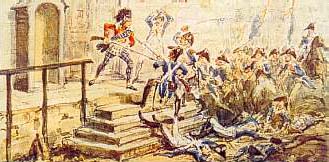
Batlle of Castlebar known as “Races of Castlebar”.
Following a number of attacks in which they were hit by British cannon, Humbert decided to regroup and divided his troops, splitting them to the left and right so as to attack the English flanks. The Irish drove a herd of cattle ahead of them causing confusion in the English rank. The French/Irish made an effective bayonet charge through the centre.
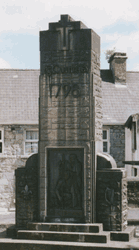
Castlebar Memorial
The English retreated down Staball Hill. Another attack occurred at Main St. Bridge. The English defended the bridge for some time using forces from the Longford and Kilkenny militias and Fraser Fencibles (a Scottish regiment).
There was confused fighting in the town as knots of the more stalwart British, notably the Fraser Fencibles and Roden’s Dragoons, attempted to make a stand.
The bulk of the redcoat forces, abandoning all guns, standards, and baggage, ran in headlong flight down the road to Tuam, 54 km (34 miles) to the southeast; some apparently did not stop until reaching Athlone, a further 68 km (42 miles) away. General Lake’s army being dissolved.
The event has since become mockingly known among the Irish as “The Castlebar Races.” In all the attack only lasted six hours from 6a.m. to 12 noon and has been described by Thomas Pakenham in The Year of Liberty as one of the most ignominious defeats in British military history. Following this brilliant victory, Humbert spent the next few days resting and reorganizing his army, absorbing many hundreds of new Irish volunteers including some 250 deserters from the Longford and Kilkenny Militias.The “Republic of Connaught” was proclaimed and a makeshift revolutionary government installed.Army of Ireland – Liberty, Equality
Head quarters at Castlebar, 14th Fructidor, sixth Year of the French Republic, One and Indivisible. General Humbert, Commander in Chief of the Army of Ireland, desirous of organizing with the least possible delay, an administrative power for the Province of Connaught, decrees as follows:
1. The Government of the Province of Connaught shall reside at Castlebar till further orders. 2. The Government shall be composed of twelve members, who shall be named by the General-in-chief of the French Army. 3. Citizen JOHN MOORE is named President of the Government of the Province of Connaught, he is specially entrusted with the nomination and reunion of the members of the Government. 4. The Government shall occupy itself immediately in organizing the Military power of the Province of Connaught, and with providing subsistence for the French and Irish Armies. 5. There shall be organized eight regiments of infantry, each of twelve hundred men, and four regiments of cavalry, each of six hundred men. 6. The Government shall declare rebels and traitors to the country all those who having received clothing and arms, shall not join the army within four and twenty hours. 7. Every individual from sixteen years of age to forty, inclusive, is REQUIRED in the name of the Irish Republic, to betake himself instantly to the French Camp, to march in a mass against the common enemy. The General Commanding-in-Chief HUMBERT.Lord Cornwallis (the same who had surrendered to Washington at Yorktown), now the Viceroy and Commander-in-Chief in Ireland, moved west from Dublin to take personal command of the campaign.It was obvious that after the fiasco of Castlebar, the Crown forces in Ireland would marshal every possible resource to crush Humbert.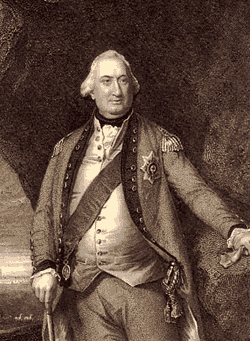
Lord Cornwallis
By the 2nd of September, Cornwallis had 7,800 men, including two reliable Scottish regiments (the Sutherland and Rehy Fencibles) concentrated at Tuam, organized into four brigades under Generals Hunter, Campbell, Hutchinson, and Moore (later the hero of Corunna), and a further 2,800 at Boyle.
Cornwallis advanced from Tuam on the 4th of September, but on arriving at Castlebar on the 5th found only a small Franco-Irish rearguard. Aware of the impossibility of defeating the well-equipped and far more numerous Crown forces, and with no sign of reinforcements from France, Humbert had marched off to the east on 4 September, under cover of darkness, taking his army, now totalling 3,000 men, towards Sligo, covering 58 miles in 36 hours. The long march had begun. Some Irish troops under French officers remained to protect Killala and receive the expected reinforcements.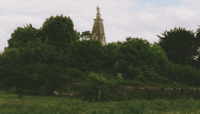
Collooney, Co. Sligo
On the morning of the 5th of September, an English army from Sligo under Col Vereker attacks the Franco-Irish army at Collooney with its left protected by the Ballysadare River and its right anchored on a steep, wooded hill. Humbert again outmanoeuvres them.
In what may be one of the greatest feats of individual bravery in the long history of the Revolutionary and Napoleonic Wars, Colonel Bartholomew Teeling, a United Irishman holding a French commission, galloped forward alone to the British line, pistolled the enemy gunner at point-blank range, and rode back unscathed under a hail of musket-fire. Inspired by his example, the Irish and French surged forward and routed the Loyalists. The English retreated with heavy losses as far as Ballyshannon, County Donegal.Cornwallis has now divided his army in two, one half under General Lake to pursue the enemy and the other half, under his own personal command, to protect the line of the river Shannon.
Ballinamuck pikeman
The French and Irish “must not cross”. Meanwhile, the United Irishmen of Longford and Westmeath have assembled. They capture Wilson’s Hospital near Mullingar but fail to take the town of Granard. Humbert, on hearing of the midlands rising decides to link up with the insurgents there.He is now near Manorhamilton but changes and goes straight for Granard. He abandons some of the heavier guns so as to make more speed. So far he has eluded the cordon closing in around him. With some luck he hopes to slip past the net, reach Granard and then strike for Dublin which is virtually unprotected as most of the garrison have been moved to Connacht. The Franco-Irish army reaches Drumkeerin in the evening of September 6. An envoy from Lord Cornwallis offers terms for surrender but they are rejected.On September 7, shortly before noon Humbert’s army crosses the Shannon at Ballintra Bridge just south of Loch Allen, but they fail in an attempt to demolish the bridge behind them.
His army shows signs of fatigue and skirmishes with the English advance guard become more frequent. The race for Granard quickens.
The Franco-Irish army reaches Cloone, in South Leitrim, while Cornwallis, with 15,000 men is at Mohill, five miles away. Humbert gets news that he is surrounded and outnumbered but decides to push on even if the best he can now do is to make a token resistance before surrender.On September 8, 1798, near the small village of Ballinamuck, County Longford, Humbert drew up his 859 French troops in line of battle. There could be little doubt of the outcome.
Behind Humbert was Cornwallis blocking Humbert’s way to Dublin. In front was Lake’s 6000 men. The battle which lasted but half an hour commenced with Colonel Crawford’s dragoons cutting through the Irish rebels. When the British grand assault poured up the hill from three sides, in overwhelming numbers, Humbert gave the order to surrender.
Humbert surrenders in Ballinamuck
The French officers followed their general’s signal and ordered their men to lay down their muskets. A second body of British cavalry had reined in seeing the signs of surrender, but Colonel Teeling, an Irish officer in the French army, had not signaled surrender so British infantry advanced on them. Crawford attacked a large contingent of Irishmen with his dragoons, their sabres sparing only those with officers insignia, hanging to be their fate.
Later testimonies reveal that on arresting Humbert, General Lake could not conceal his astonishment: “Where is your army?” Lake demanded “This is it all” Humbert replied, indicating his soldiers. “And what were you planning to do with this lot?” Lake asked. “We were going to Dublin to break the irons of a nation that suffers under your yoke” Humbert said. “That is an idea that could only be born in a Frenchman’s brains!” Lake declared.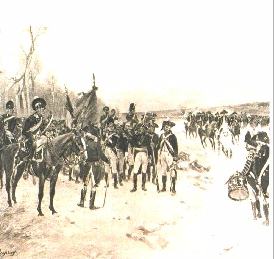
Humbert surrenders in Ballinamuck
Humbert and the French prisoners were conducted to Dublin and treated with all the consideration that could be given to gallant prisoners after an honorable defeat.
Not so the Irish. Accounts vary, but it appears that many of the Irish were cut down where they stood, or driven into the bog south of the hill where they were hunted down and slaughtered. Captured Irish officers, even those bearing legitimate commissions in the French army, were seized and hanged as traitors. Such was Bartholomew Teeling, Matthew Tone and Gunner James Magee’s fate.“After having obtained the greatest successes and made the arms of the French Republic triumph during my stay in Ireland, I have at length been obliged to submit to a superior force of 30,000 troops.” General Humbert’s Report to the French Directory after Ballinamuck.
‘A SHORT BUT VERY FATIGUING CAMPAIGN’
English historians have always treated General Humbert’s expedition to Ireland with ridicule, but Brian O hUiginn was fond of quoting Plowden the military correspondent of the London Times who held a different view. This expert wrote some years ago:
“In these operations described by Cornwallis to the Duke of Portland as a short but very fatiguing campaign, a raiding party of 1000 French landed in Ireland without opposition, after sixteen days of navigation, unobserved by the British Navy; defeated and drove back the British troops opposing them on four separate occasions; routed a force of second line troops of at least double its strength; captured eleven British guns; held the field for seventeen days; entirely occupied the attention of all the available troops of a garrison of Ireland 150,000 strong; penetrated almost to the centre of the island, and compelled the Lord Lieutenant to send an urgent requisition to London for ‘as great a reinforcement as possible.’ “
This was a fine tribute to General Humbert and his troops.- In Humbert’s footsteps 2013 – Killala & Castlebar
- In Humbert’s footsteps 2013 – Killala & Castlebar
- In Humbert’s footsteps 2013 – Killala & Castlebar
- In Humbert’s footsteps 2013 – Killala & Castlebar
The Charentais of the expedition.
Many Charentais took part in the expedition. Among them: Daniel Savary, who was born in Salles sur Mer (17), was in command of the naval division charged with transporting the expedition from La Rochelle to Killala. François Babin, born in Péré (17), became Commander of the Castlebar battalion. Jean Jobit, born in Chateauneuf en Charente (16), was a Commander on the Castlebar battlefield in Castlebar. Jean-Paul Leugerat, born in Barbezières (16), died during the battle of Castlebar.


